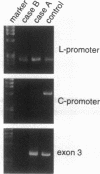Abstract
The dystrophin gene, which is mutated in patients with Duchenne and Becker muscular dystrophies, is the largest known human gene. Five alternative promoters have been characterized until now. Here we show that a novel dystrophin isoform with a different first exon can be produced through transcription initiation at a previously unidentified alternative promoter. The case study presented is that of a patient with Duchenne muscular dystrophy who had a deletion extending from the 5' end of the dystrophin gene to exon 2, including all promoters previously mapped in the 5' part of the gene. Transcripts from lymphoblastoid cells were found to contain sequences corresponding to exon 3, indicating the presence of new promoter upstream of this exon. The nucleotide sequence of amplified cDNA corresponding to the 5' end of the new transcript indicated that the 5' end of exon 3 was extended by 9 codons, only the last (most 3') of which codes for methionine. The genomic nucleotide sequence upstream from the new exon, as determined using inverse polymerase chain reaction, revealed the presence of sequences similar to a TATA box, an octamer motif and an MEF-2 element. The identified promoter/exon did not map to intron 2, as might have been expected, but to a position more than 500 kb upstream of the most 5' of the previously identified promoters, thereby adding 500 kb to the dystrophin gene. The sequence of part of the new promoter region is very similar to that of certain medium reiteration frequency repetitive sequences. These findings may help us understand the molecular evolution of the dystrophin gene.
Full text
PDF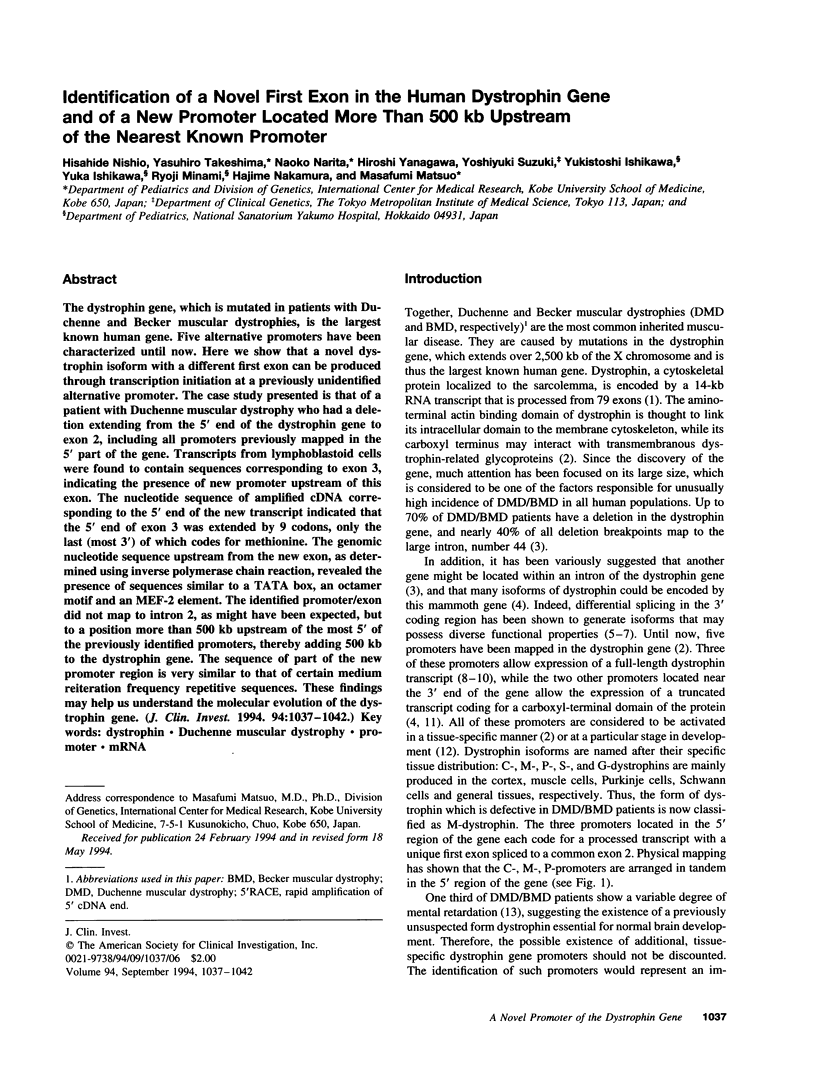
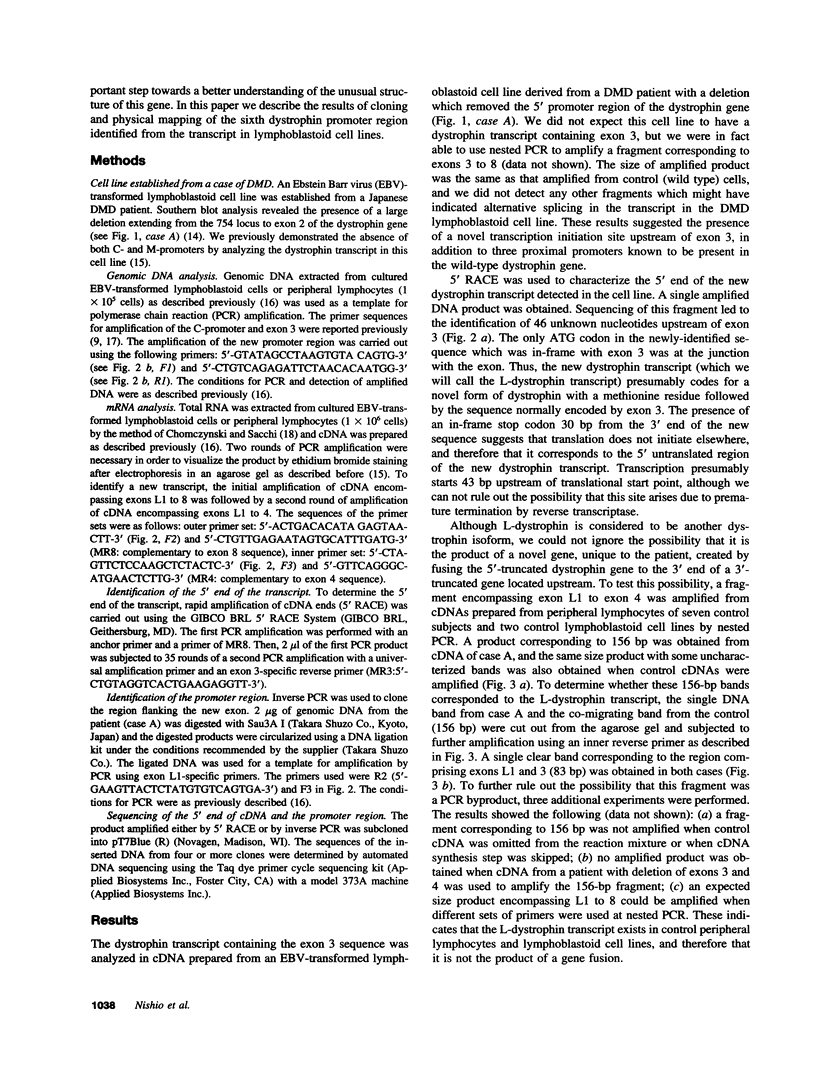
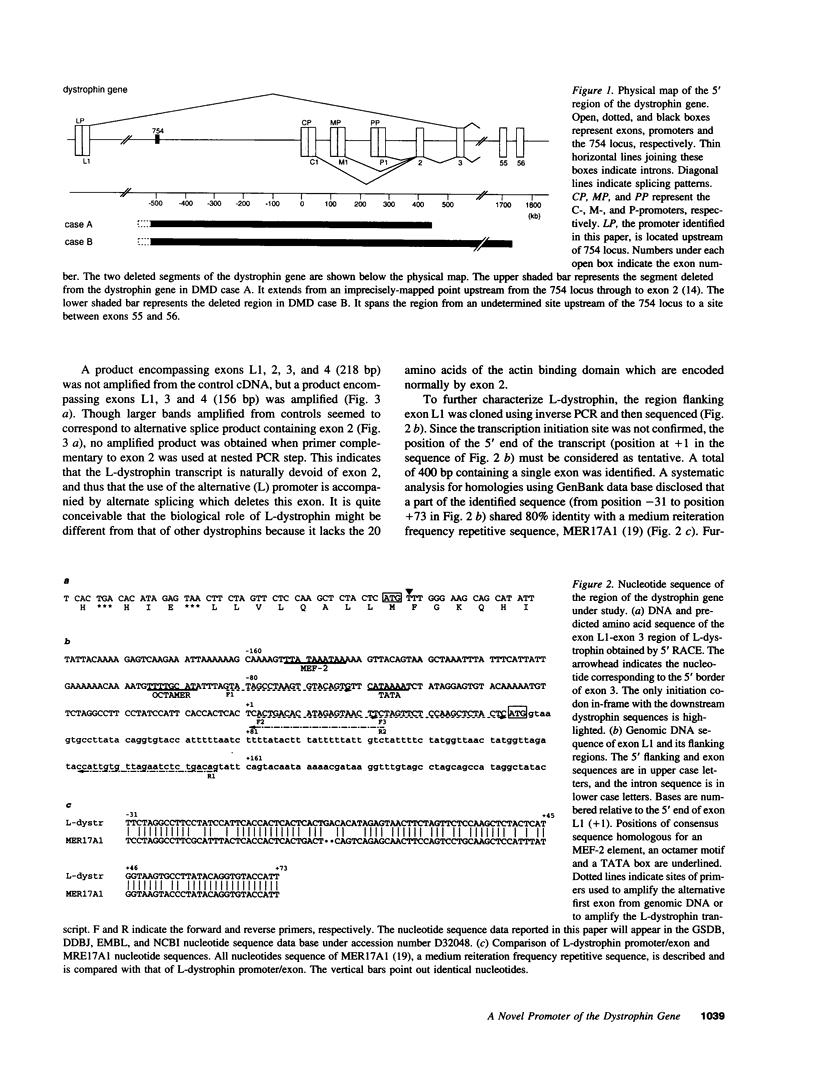
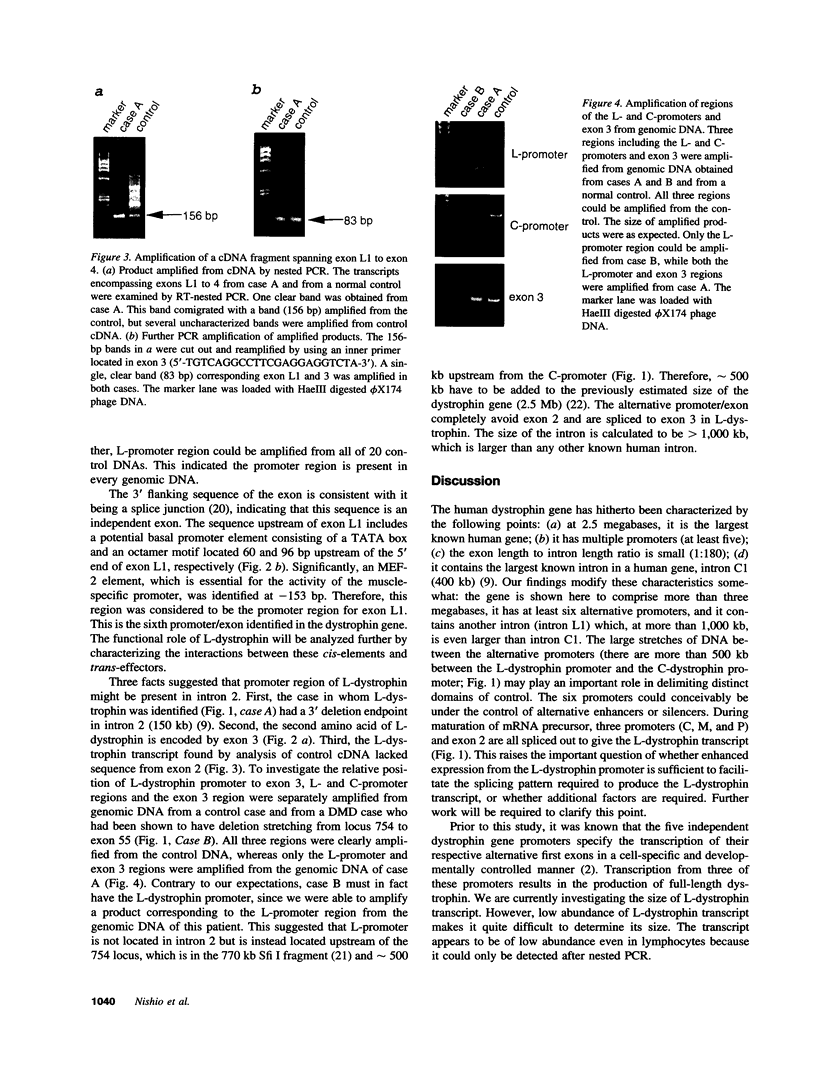
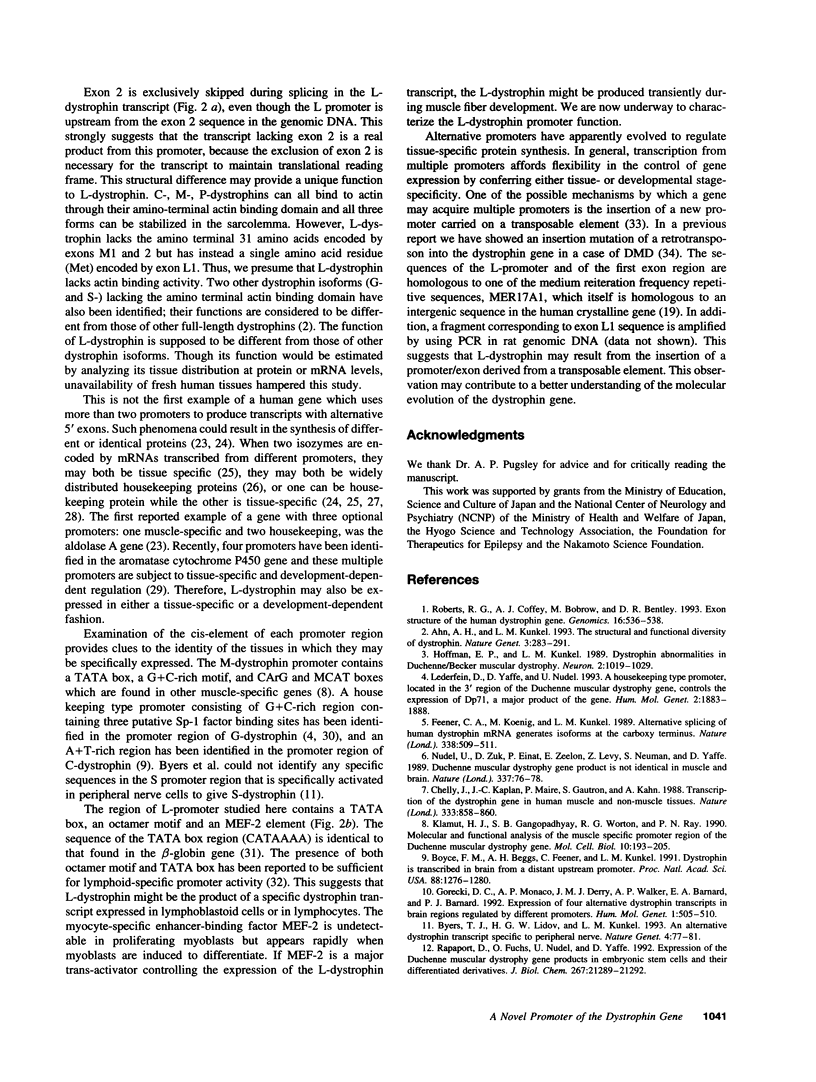
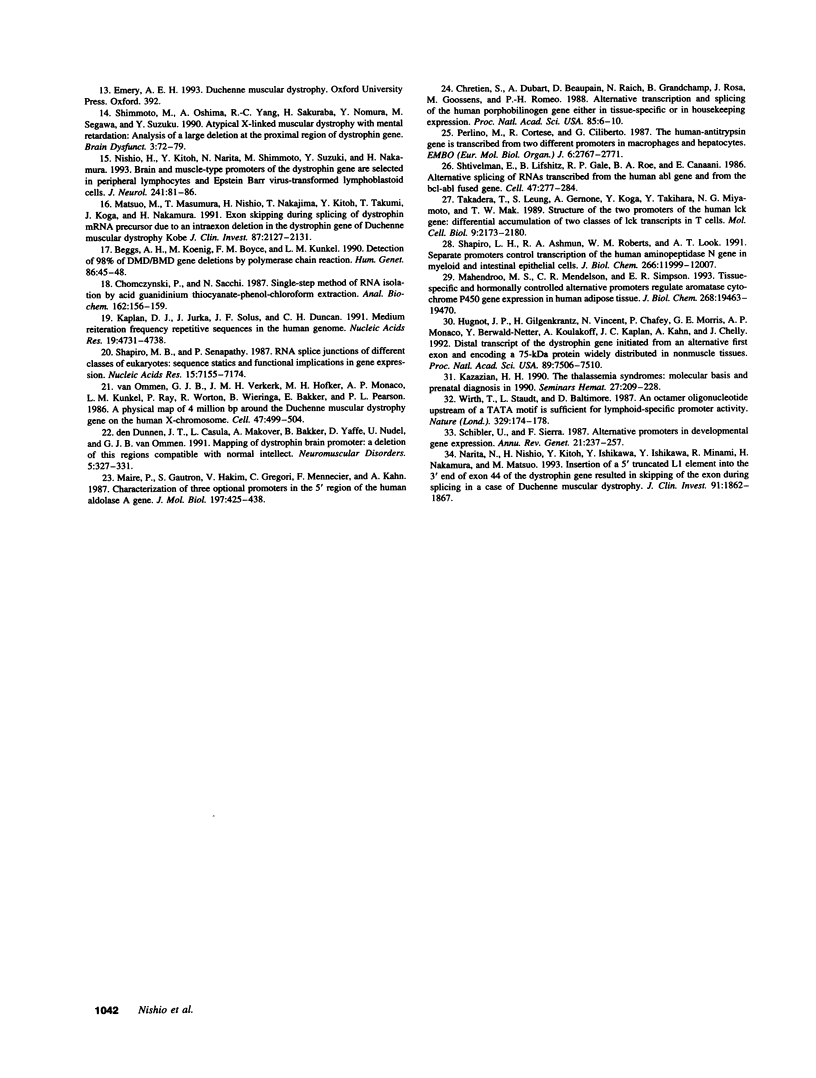
Images in this article
Selected References
These references are in PubMed. This may not be the complete list of references from this article.
- Ahn A. H., Kunkel L. M. The structural and functional diversity of dystrophin. Nat Genet. 1993 Apr;3(4):283–291. doi: 10.1038/ng0493-283. [DOI] [PubMed] [Google Scholar]
- Beggs A. H., Koenig M., Boyce F. M., Kunkel L. M. Detection of 98% of DMD/BMD gene deletions by polymerase chain reaction. Hum Genet. 1990 Nov;86(1):45–48. doi: 10.1007/BF00205170. [DOI] [PubMed] [Google Scholar]
- Boyce F. M., Beggs A. H., Feener C., Kunkel L. M. Dystrophin is transcribed in brain from a distant upstream promoter. Proc Natl Acad Sci U S A. 1991 Feb 15;88(4):1276–1280. doi: 10.1073/pnas.88.4.1276. [DOI] [PMC free article] [PubMed] [Google Scholar]
- Byers T. J., Lidov H. G., Kunkel L. M. An alternative dystrophin transcript specific to peripheral nerve. Nat Genet. 1993 May;4(1):77–81. doi: 10.1038/ng0593-77. [DOI] [PubMed] [Google Scholar]
- Chelly J., Kaplan J. C., Maire P., Gautron S., Kahn A. Transcription of the dystrophin gene in human muscle and non-muscle tissue. Nature. 1988 Jun 30;333(6176):858–860. doi: 10.1038/333858a0. [DOI] [PubMed] [Google Scholar]
- Chomczynski P., Sacchi N. Single-step method of RNA isolation by acid guanidinium thiocyanate-phenol-chloroform extraction. Anal Biochem. 1987 Apr;162(1):156–159. doi: 10.1006/abio.1987.9999. [DOI] [PubMed] [Google Scholar]
- Chretien S., Dubart A., Beaupain D., Raich N., Grandchamp B., Rosa J., Goossens M., Romeo P. H. Alternative transcription and splicing of the human porphobilinogen deaminase gene result either in tissue-specific or in housekeeping expression. Proc Natl Acad Sci U S A. 1988 Jan;85(1):6–10. doi: 10.1073/pnas.85.1.6. [DOI] [PMC free article] [PubMed] [Google Scholar]
- Feener C. A., Koenig M., Kunkel L. M. Alternative splicing of human dystrophin mRNA generates isoforms at the carboxy terminus. Nature. 1989 Apr 6;338(6215):509–511. doi: 10.1038/338509a0. [DOI] [PubMed] [Google Scholar]
- Górecki D. C., Monaco A. P., Derry J. M., Walker A. P., Barnard E. A., Barnard P. J. Expression of four alternative dystrophin transcripts in brain regions regulated by different promoters. Hum Mol Genet. 1992 Oct;1(7):505–510. doi: 10.1093/hmg/1.7.505. [DOI] [PubMed] [Google Scholar]
- Hoffman E. P., Kunkel L. M. Dystrophin abnormalities in Duchenne/Becker muscular dystrophy. Neuron. 1989 Jan;2(1):1019–1029. doi: 10.1016/0896-6273(89)90226-2. [DOI] [PubMed] [Google Scholar]
- Hugnot J. P., Gilgenkrantz H., Vincent N., Chafey P., Morris G. E., Monaco A. P., Berwald-Netter Y., Koulakoff A., Kaplan J. C., Kahn A. Distal transcript of the dystrophin gene initiated from an alternative first exon and encoding a 75-kDa protein widely distributed in nonmuscle tissues. Proc Natl Acad Sci U S A. 1992 Aug 15;89(16):7506–7510. doi: 10.1073/pnas.89.16.7506. [DOI] [PMC free article] [PubMed] [Google Scholar]
- Kaplan D. J., Jurka J., Solus J. F., Duncan C. H. Medium reiteration frequency repetitive sequences in the human genome. Nucleic Acids Res. 1991 Sep 11;19(17):4731–4738. doi: 10.1093/nar/19.17.4731. [DOI] [PMC free article] [PubMed] [Google Scholar]
- Kazazian H. H., Jr The thalassemia syndromes: molecular basis and prenatal diagnosis in 1990. Semin Hematol. 1990 Jul;27(3):209–228. [PubMed] [Google Scholar]
- Klamut H. J., Gangopadhyay S. B., Worton R. G., Ray P. N. Molecular and functional analysis of the muscle-specific promoter region of the Duchenne muscular dystrophy gene. Mol Cell Biol. 1990 Jan;10(1):193–205. doi: 10.1128/mcb.10.1.193. [DOI] [PMC free article] [PubMed] [Google Scholar]
- Lederfein D., Yaffe D., Nudel U. A housekeeping type promoter, located in the 3' region of the Duchenne muscular dystrophy gene, controls the expression of Dp71, a major product of the gene. Hum Mol Genet. 1993 Nov;2(11):1883–1888. doi: 10.1093/hmg/2.11.1883. [DOI] [PubMed] [Google Scholar]
- Mahendroo M. S., Mendelson C. R., Simpson E. R. Tissue-specific and hormonally controlled alternative promoters regulate aromatase cytochrome P450 gene expression in human adipose tissue. J Biol Chem. 1993 Sep 15;268(26):19463–19470. [PubMed] [Google Scholar]
- Maire P., Gautron S., Hakim V., Gregori C., Mennecier F., Kahn A. Characterization of three optional promoters in the 5' region of the human aldolase A gene. J Mol Biol. 1987 Oct 5;197(3):425–438. doi: 10.1016/0022-2836(87)90556-0. [DOI] [PubMed] [Google Scholar]
- Matsuo M., Masumura T., Nishio H., Nakajima T., Kitoh Y., Takumi T., Koga J., Nakamura H. Exon skipping during splicing of dystrophin mRNA precursor due to an intraexon deletion in the dystrophin gene of Duchenne muscular dystrophy kobe. J Clin Invest. 1991 Jun;87(6):2127–2131. doi: 10.1172/JCI115244. [DOI] [PMC free article] [PubMed] [Google Scholar]
- Narita N., Nishio H., Kitoh Y., Ishikawa Y., Ishikawa Y., Minami R., Nakamura H., Matsuo M. Insertion of a 5' truncated L1 element into the 3' end of exon 44 of the dystrophin gene resulted in skipping of the exon during splicing in a case of Duchenne muscular dystrophy. J Clin Invest. 1993 May;91(5):1862–1867. doi: 10.1172/JCI116402. [DOI] [PMC free article] [PubMed] [Google Scholar]
- Nishio H., Matsuo M., Kitoh Y., Narita N., Shimmoto M., Suzuki Y., Nakamura H. Brain- and muscle-type promoters of the dystrophin gene are selected in peripheral lymphocytes and Epstein Barr virus-transformed lymphoblastoid [correction of lymphoplastoid] cells. J Neurol. 1993 Dec;241(2):81–86. doi: 10.1007/BF00869768. [DOI] [PubMed] [Google Scholar]
- Nudel U., Zuk D., Einat P., Zeelon E., Levy Z., Neuman S., Yaffe D. Duchenne muscular dystrophy gene product is not identical in muscle and brain. Nature. 1989 Jan 5;337(6202):76–78. doi: 10.1038/337076a0. [DOI] [PubMed] [Google Scholar]
- Perlino E., Cortese R., Ciliberto G. The human alpha 1-antitrypsin gene is transcribed from two different promoters in macrophages and hepatocytes. EMBO J. 1987 Sep;6(9):2767–2771. doi: 10.1002/j.1460-2075.1987.tb02571.x. [DOI] [PMC free article] [PubMed] [Google Scholar]
- Rapaport D., Fuchs O., Nudel U., Yaffe D. Expression of the Duchenne muscular dystrophy gene products in embryonic stem cells and their differentiated derivatives. J Biol Chem. 1992 Oct 25;267(30):21289–21292. [PubMed] [Google Scholar]
- Roberts R. G., Coffey A. J., Bobrow M., Bentley D. R. Exon structure of the human dystrophin gene. Genomics. 1993 May;16(2):536–538. doi: 10.1006/geno.1993.1225. [DOI] [PubMed] [Google Scholar]
- Schibler U., Sierra F. Alternative promoters in developmental gene expression. Annu Rev Genet. 1987;21:237–257. doi: 10.1146/annurev.ge.21.120187.001321. [DOI] [PubMed] [Google Scholar]
- Shapiro L. H., Ashmun R. A., Roberts W. M., Look A. T. Separate promoters control transcription of the human aminopeptidase N gene in myeloid and intestinal epithelial cells. J Biol Chem. 1991 Jun 25;266(18):11999–12007. [PubMed] [Google Scholar]
- Shapiro M. B., Senapathy P. RNA splice junctions of different classes of eukaryotes: sequence statistics and functional implications in gene expression. Nucleic Acids Res. 1987 Sep 11;15(17):7155–7174. doi: 10.1093/nar/15.17.7155. [DOI] [PMC free article] [PubMed] [Google Scholar]
- Shtivelman E., Lifshitz B., Gale R. P., Roe B. A., Canaani E. Alternative splicing of RNAs transcribed from the human abl gene and from the bcr-abl fused gene. Cell. 1986 Oct 24;47(2):277–284. doi: 10.1016/0092-8674(86)90450-2. [DOI] [PubMed] [Google Scholar]
- Takadera T., Leung S., Gernone A., Koga Y., Takihara Y., Miyamoto N. G., Mak T. W. Structure of the two promoters of the human lck gene: differential accumulation of two classes of lck transcripts in T cells. Mol Cell Biol. 1989 May;9(5):2173–2180. doi: 10.1128/mcb.9.5.2173. [DOI] [PMC free article] [PubMed] [Google Scholar]
- Wirth T., Staudt L., Baltimore D. An octamer oligonucleotide upstream of a TATA motif is sufficient for lymphoid-specific promoter activity. Nature. 1987 Sep 10;329(6135):174–178. doi: 10.1038/329174a0. [DOI] [PubMed] [Google Scholar]
- den Dunnen J. T., Casula L., Makover A., Bakker B., Yaffe D., Nudel U., van Ommen G. J. Mapping of dystrophin brain promoter: a deletion of this region is compatible with normal intellect. Neuromuscul Disord. 1991;1(5):327–331. doi: 10.1016/0960-8966(91)90118-c. [DOI] [PubMed] [Google Scholar]
- van Ommen G. J., Verkerk J. M., Hofker M. H., Monaco A. P., Kunkel L. M., Ray P., Worton R., Wieringa B., Bakker E., Pearson P. L. A physical map of 4 million bp around the Duchenne muscular dystrophy gene on the human X-chromosome. Cell. 1986 Nov 21;47(4):499–504. doi: 10.1016/0092-8674(86)90614-8. [DOI] [PubMed] [Google Scholar]





